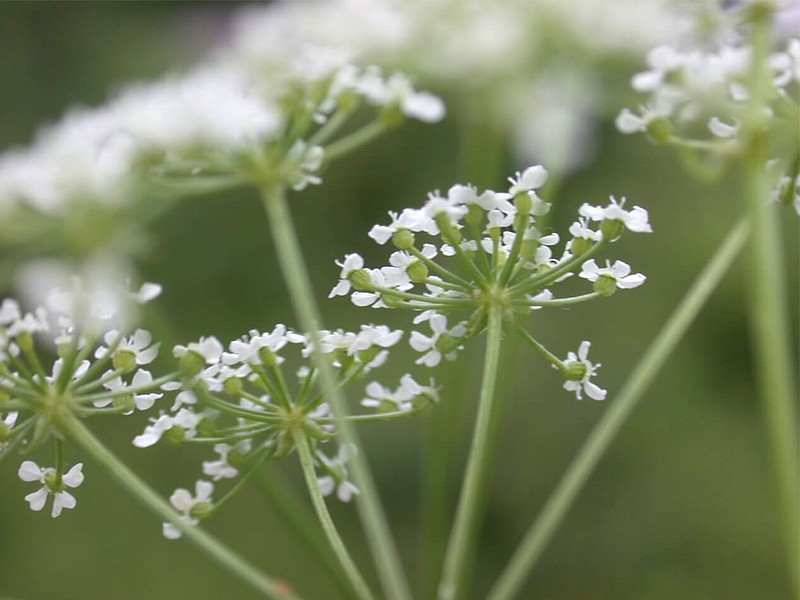Q: There has been a lot of concern and many posts on our Bella Vista Neighbors site about how to tell the difference between Queen Anne's lace and hemlock. There is a lot of Queen Anne's lace here, and some have reported hemlock, so people are nervous. Pictures have been posted of both. Can you contribute anything more that would help differentiate between the two plants? I still see you as our plant expert.
A: Poison hemlock and Queen Anne's lace are in the carrot family and do look somewhat similar. They have similar foliage and an umbel flower (a flat cluster of individual white flowers that make up a full flower head). On Queen Anne's lace, the flowers tend to be flatter in shape, while the umbel on poison hemlock is more rounded. Queen Anne's lace has a small purple flower in the center of the cluster of blooms, while all the blooms are white on hemlock. Two more differences can be noted on the stems. Poison hemlock will have purple blotches on the smooth stem, while mature Queen Anne's lace will be solid green and hairy. The University of Arkansas Cooperative Extension Service has more information and images of poison hemlock here: arkansasonline.com/704hemlock. Hope this helps.
■ ■ ■
Q: I moved into a new independent living place and found this plant [the reader sent a photo]. At the time there were only dead white stalks. Patience paid off. Leaves are purple and green. I have two red and three white on different plants. Can you tell me what they are? The plants are almost 4 feet tall and have many buds.
A: The plant in question is a hardy hibiscus. The plants produce woody stalks, and they have huge flowers in June and July. After a killing frost in the fall, they will die to the ground, but they return the next spring. The plants can have green or red foliage with red, pink or white blooms.
Q: I bought some summer-flowering bulbs on clearance at Walmart and wonder if it's too late to plant and better to wait until fall. They are gladioli, columbine and Asclepias. I want to add color in a bed that is primarily tiger lilies (which have bloomed and dropped). Will they overwinter or need to be replanted every year? I know the lilies do; I have divided them three times already and they're due for another.
A: I would plant the gladioli and the Asclepias (milkweed) now. They are both great summer-flowering plants, and you should have time for them to get growing and still bloom this summer. Store the columbine in a cool place and plant in the fall, since they are a late winter/early spring bloomer. They would not take the intense heat right now at all well. All of these plants should be perennial plants.
■ ■ ■
Q: I have planted tomato plants in containers for several years. This is the first time I have seen this particular problem. I have a Big Boy tomato plant that has developed brown spots on several stalks. Is there anything I can do to stop this from developing on the rest of the plant? It already has several large green tomatoes on it.
A: There are a lot of tomato diseases and if you are reusing the same potting soil from year to year, the problems will start sooner rather than later. While there are spray schedules for tomato plants, you have to spray fairly regularly to prevent them. Once they start, then it is difficult to stop it. Several of the diseases, such as Septoria leaf spot, will persist and move up the plant, but you should still get a harvest without spraying. When you finish with this crop, throw away the old soil, clean the pots and start fresh for a fall crop or wait until next spring.
■ ■ ■
Q: In the June 25 response to a reader that had leaf depredation on a plum tree you suggested Japanese beetles could be the culprit. I have had a lot of experience controlling June bugs, whose damage can be similar. When my wife and I retired we moved to southwestern Arkansas and planted fruit trees. We were inundated with June bugs or chafer beetles. We took matters into our own hands — literally. We hand-picked the bugs from trees across the yard. June bugs are quite easy to pick since they do not bite to defend themselves and — since they do their work at night — seem to have few natural predators. My wife and I would spend a little more than one hour each night on our circuit from tree to tree. The June bug population seemed to peak according to temperature and humidity, which differed each year depending on weather. We would grab the June bugs and put them into a large container and freeze it at the end of the night. Once frozen, we would consolidate them into large plastic bags and share them with a neighbor who had chickens. The chickens loved the bugs, and we got free eggs. Based on my nightly capture records (2007-2014), I calculated that we collected more than 60,000 June bugs! Now our population is way down.
A: You have more patience and stamina than I do. Great job!
Retired after 38 years with the University of Arkansas Cooperative Extension Service, Janet Carson ranks among Arkansas' best known horticulture experts. Her blog is at arkansasonline.com/planitjanet. Write to her at P.O. Box 2221, Little Rock, AR 72203 or email jcarson@arkansasonline.com
